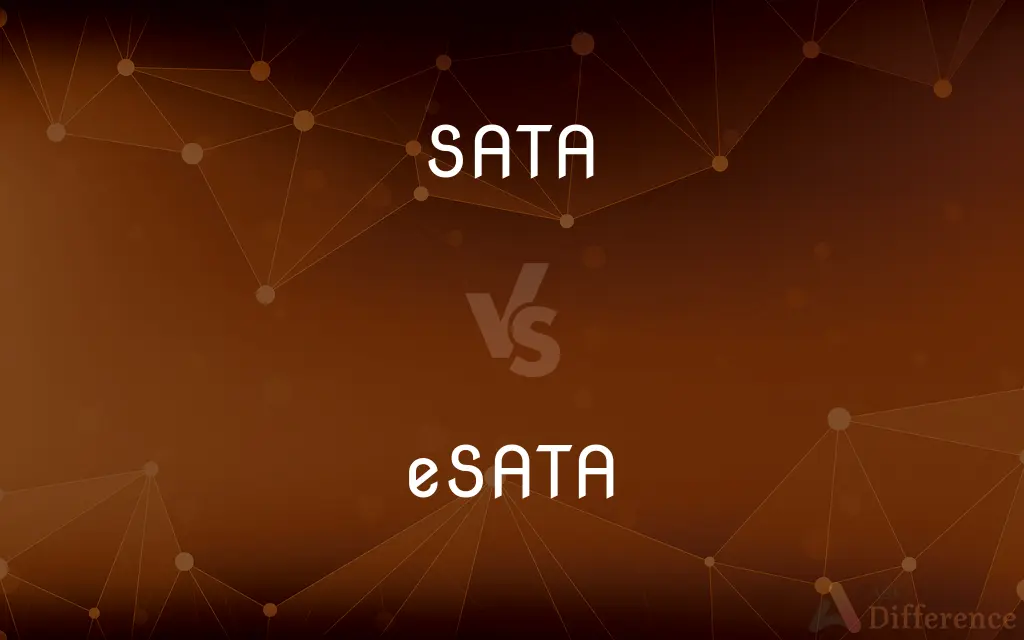SATA vs. eSATA — What's the Difference?
By Tayyaba Rehman — Published on January 18, 2024
SATA (Serial ATA) is a standard interface for connecting internal storage devices, while eSATA (External SATA) is a variation of SATA designed for external connectivity.

Difference Between SATA and eSATA
Table of Contents
ADVERTISEMENT
Key Differences
SATA, or Serial Advanced Technology Attachment, is an interface used primarily for connecting internal hard drives and SSDs to a computer motherboard. eSATA, or External SATA, is an extension of the SATA interface, specifically designed for external storage devices.
The main distinction between SATA and eSATA is their application; SATA is used within the computer system for internal storage, while eSATA is used for connecting external storage devices without losing the speed and efficiency of SATA.
In terms of design, eSATA connectors are slightly different to withstand external use and disconnection. SATA connectors are designed for internal use and aren’t as robust against frequent unplugging and plugging.
Speed-wise, both SATA and eSATA offer similar data transfer rates. However, eSATA can provide faster transfer speeds compared to other external interfaces like USB 2.0 or FireWire.
While SATA is the standard for internal drives, eSATA isn’t as widely used due to the popularity of USB 3.0 and Thunderbolt interfaces for external storage solutions, which offer similar or higher speeds and more universal compatibility.
ADVERTISEMENT
Comparison Chart
Application
Internal storage connectivity
External storage connectivity
Connector Design
Designed for internal, less frequent disconnections
Built for durability in external environments
Use Case
Connecting drives inside a computer
Connecting external hard drives
Data Transfer Speed
High-speed data transfer
Similar to SATA, faster than older external interfaces
Popularity
Standard for internal drives
Less common due to USB 3.0 and Thunderbolt
Compare with Definitions
SATA
Internal use design
SATA cables are designed to stay connected and rarely moved.
eSATA
Faster than USB 2.0
My eSATA connection transfers files faster than my old USB 2.0 drive.
SATA
High-speed data transfer
SATA supports faster data transfer rates for internal drives.
eSATA
Alternative to USB and Thunderbolt
Before USB 3.0, I preferred eSATA for external storage.
SATA
Internal storage interface
My computer's hard drive is connected via a SATA interface.
eSATA
Durable connector design
ESATA cables are more durable for regular unplugging.
SATA
Motherboard connectivity
The motherboard has multiple SATA ports for additional drives.
eSATA
External storage connectivity
I connected my external hard drive using an eSATA port.
SATA
Standard for hard drives and SSDs
Most modern SSDs use a SATA connection.
eSATA
Used for external drives
I use an eSATA port for my external backup drive.
Common Curiosities
Is eSATA faster than USB?
eSATA is faster than older USB versions like USB 2.0, but comparable or slower than USB 3.0 and Thunderbolt.
Are SATA and eSATA connectors the same?
They are similar but eSATA connectors are designed for external use and are more durable.
Can I use a SATA drive with an eSATA port?
Yes, with an appropriate eSATA to SATA cable or enclosure.
Do all computers have eSATA ports?
No, eSATA ports are less common and not found on all computers.
Can I use eSATA for internal drives?
eSATA is designed for external drives, so it's not ideal for internal use.
What does SATA stand for?
SATA stands for Serial Advanced Technology Attachment.
How fast is SATA?
SATA data transfer rates vary, with SATA III supporting up to 6 Gb/s.
Do I need a special cable for eSATA?
Yes, an eSATA cable is required for connecting eSATA devices.
Is eSATA compatible with all external hard drives?
Only if the external drive has an eSATA interface.
What are the advantages of eSATA over USB?
eSATA typically provides faster data transfer rates compared to older USB versions.
What is eSATA used for?
eSATA is used for connecting external storage devices to a computer.
Are eSATA cables different from SATA cables?
Yes, eSATA cables are designed to be more durable for external use.
Can I convert USB to eSATA?
There are adapters available to connect USB to eSATA, but they may not support the full speed of eSATA.
Are there different versions of SATA?
Yes, there are different versions like SATA I, SATA II, and SATA III, offering different speeds.
Is SATA still used in new computers?
Yes, SATA is still widely used for internal hard drives and SSDs.
Share Your Discovery

Previous Comparison
Where Clause in SQL vs. Having Clause in SQL
Next Comparison
Call Option vs. Put OptionAuthor Spotlight
Written by
Tayyaba RehmanTayyaba Rehman is a distinguished writer, currently serving as a primary contributor to askdifference.com. As a researcher in semantics and etymology, Tayyaba's passion for the complexity of languages and their distinctions has found a perfect home on the platform. Tayyaba delves into the intricacies of language, distinguishing between commonly confused words and phrases, thereby providing clarity for readers worldwide.
















































